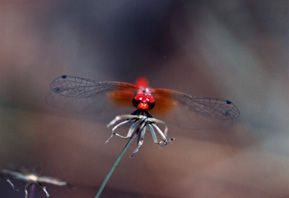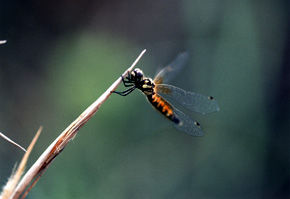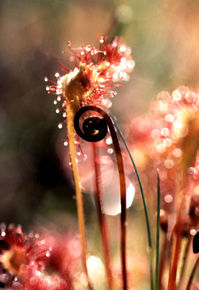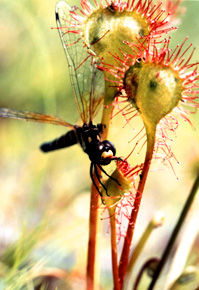|
|
|
|
|
|
|
|
|
|
|
|
|
|
|
|
|
|
|
|
|
|
|
|
|
|
|
|
|
|
|
|
|
|
|
|
|
| It becomes fewer and fewer everglades and small ponds in Japan, because of development. There are many kind of everglades in Japan, such as shallow one, deep one, sunny one, shaded one in woods, and so on. Many kind of dragonflies are known. Their life depends on the circumstances very deeply. Accordingly, it is possible to speculate how the everglade is, from the species of dragonflies living around the everglade. This time, I focus on a small everglade on the mountain side of Mt. Hira near Lake Biwa. |
|
|
|
|
|
|
|
 |
 |
| "Nannophya pygmaea", male, "Haccho Tombo" in Japanese |
"Nannophya pygmaea", female |
| "Hey, Nabe-chan, don't you know a place where curious plant, "Mousen-Goke" can be observed near my house." Komo-chan, my friend living and running an animal hospital at the mountain side of Mt. Hira, guided me to the everglade. When we entered narrow entrance among low bush, there we found a shallow everglade, surrounded by mountain at the west and south sides. Water seems coming from the west mountain side. "This is the everglade I told you, Komo-chan said. It is not the 1st time for me to see this plant, but I was impressed with its cuteness. Then, Komo-chan continued, "Very curious tiny dragon fly, you can see here!". But, I cannot fell the atmosphere of lives. When I saw the ground, a tiny dragonfly with red color was having a rest on a grass. That's is "Haccho Tombo". It is the smallest dragonfly in Japan with 8 mm body size. Male has a red body and female has a brown body with black stripe. Generally speaking, male is more gorgeous than female in the nature world. When observing "Haccho Tombo" via Macro lens, eyes of male has two-tone colors of red and black. How fashionable it is! "Haccho Tombo" was found at "Haccho-Nawate, Yada-gawara" in Aichi prefecture. That is the origin of its name. But, there is alternative origin. It said that the dragonfly was found at "Haccho-Nawate around Jinmyo-cho in Mizuho-ku in Aichi. Anyway, the name is originated from the identified place. (Sited from "A. Usuda et al: Insects in Nagoya, Nagoya-Konchukan, 1989") |
|
|
|
|
|
|
|
 |
 |
"Haccho Tombo" appears in June and most of them disappear at the end of summer. At the end of June, I saw "Drosera rotundifolia", covering the everglade, caught many "Haccho Tombo". Maybe, they were caught when they would give eggs. The dragonfly caught tried to escape from the plant by biting the plant, but in vain. Accordingly, "Drosera rotundifolia" stored nutrition for the next generation and disappeared in July.
Click the icon, for the next page!

|
| "Drosera rotundifolia", "Mousen-Goke" in Japanese, Young leaves of pine tree begin growing adjacent to this plant. |
Female "Haccho Tombo" was caught by "Drosera rotundifolia". |
|
|
|
|
|
|
|
|
|
|
|
|
|
|
|
|
|
|
|
|
|
|
|
|
|
|







